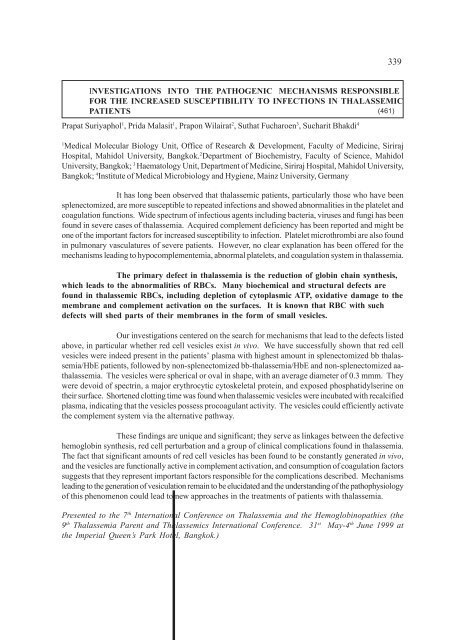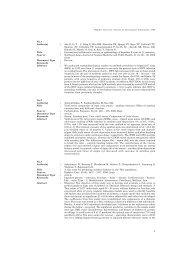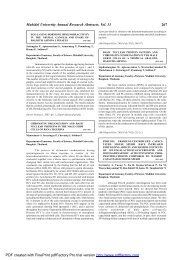THE OSTIA VENAE HEPATICAE AND THE RETHROHEPATIC ...
THE OSTIA VENAE HEPATICAE AND THE RETHROHEPATIC ...
THE OSTIA VENAE HEPATICAE AND THE RETHROHEPATIC ...
You also want an ePaper? Increase the reach of your titles
YUMPU automatically turns print PDFs into web optimized ePapers that Google loves.
INVESTIGATIONS INTO <strong>THE</strong> PATHOGENIC MECHANISMS RESPONSIBLE<br />
FOR <strong>THE</strong> INCREASED SUSCEPTIBILITY TO INFECTIONS IN THALASSEMIC<br />
PATIENTS<br />
Prapat Suriyaphol1 , Prida Malasit1 , Prapon Wilairat2 , Suthat Fucharoen3 , Sucharit Bhakdi4 (461)<br />
1 Medical Molecular Biology Unit, Office of Research & Development, Faculty of Medicine, Siriraj<br />
Hospital, Mahidol University, Bangkok. 2 Department of Biochemistry, Faculty of Science, Mahidol<br />
University, Bangkok; 3 Haematology Unit, Department of Medicine, Siriraj Hospital, Mahidol University,<br />
Bangkok; 4 Institute of Medical Microbiology and Hygiene, Mainz University, Germany<br />
It has long been observed that thalassemic patients, particularly those who have been<br />
splenectomized, are more susceptible to repeated infections and showed abnormalities in the platelet and<br />
coagulation functions. Wide spectrum of infectious agents including bacteria, viruses and fungi has been<br />
found in severe cases of thalassemia. Acquired complement deficiency has been reported and might be<br />
one of the important factors for increased susceptibility to infection. Platelet microthrombi are also found<br />
in pulmonary vasculatures of severe patients. However, no clear explanation has been offered for the<br />
mechanisms leading to hypocomplementemia, abnormal platelets, and coagulation system in thalassemia.<br />
The primary defect in thalassemia is the reduction of globin chain synthesis,<br />
which leads to the abnormalities of RBCs. Many biochemical and structural defects are<br />
found in thalassemic RBCs, including depletion of cytoplasmic ATP, oxidative damage to the<br />
membrane and complement activation on the surfaces. It is known that RBC with such<br />
defects will shed parts of their membranes in the form of small vesicles.<br />
Our investigations centered on the search for mechanisms that lead to the defects listed<br />
above, in particular whether red cell vesicles exist in vivo. We have successfully shown that red cell<br />
vesicles were indeed present in the patients’ plasma with highest amount in splenectomized bb thalassemia/HbE<br />
patients, followed by non-splenectomized bb-thalassemia/HbE and non-splenectomized aathalassemia.<br />
The vesicles were spherical or oval in shape, with an average diameter of 0.3 mmm. They<br />
were devoid of spectrin, a major erythrocytic cytoskeletal protein, and exposed phosphatidylserine on<br />
their surface. Shortened clotting time was found when thalassemic vesicles were incubated with recalcified<br />
plasma, indicating that the vesicles possess procoagulant activity. The vesicles could efficiently activate<br />
the complement system via the alternative pathway.<br />
These findings are unique and significant; they serve as linkages between the defective<br />
hemoglobin synthesis, red cell perturbation and a group of clinical complications found in thalassemia.<br />
The fact that significant amounts of red cell vesicles has been found to be constantly generated in vivo,<br />
and the vesicles are functionally active in complement activation, and consumption of coagulation factors<br />
suggests that they represent important factors responsible for the complications described. Mechanisms<br />
leading to the generation of vesiculation remain to be elucidated and the understanding of the pathophysiology<br />
of this phenomenon could lead to new approaches in the treatments of patients with thalassemia.<br />
Presented to the 7 th International Conference on Thalassemia and the Hemoglobinopathies (the<br />
9 th Thalassemia Parent and Thalassemics International Conference. 31 st May-4 th June 1999 at<br />
the Imperial Queen’s Park Hotel, Bangkok.)<br />
339

















